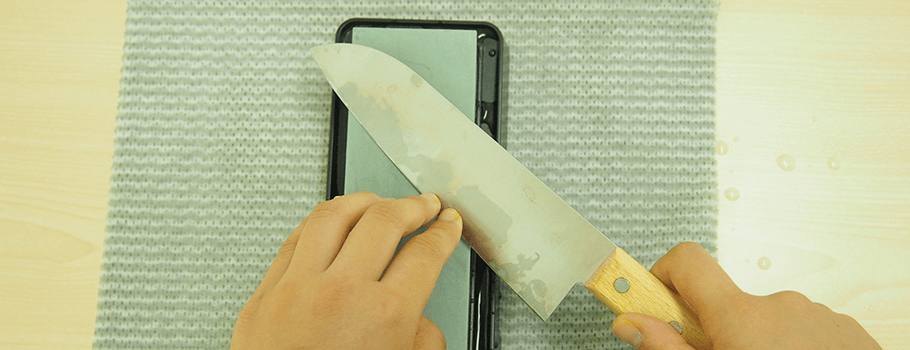
My knife is no longer sharp enough
When I put the knife against the tomato, it crushes it!
The knife slips on the skin of the chicken.
I can’t stop crying from the moment I start cutting onions…
I’m sure we’ve all experienced situations like this before.
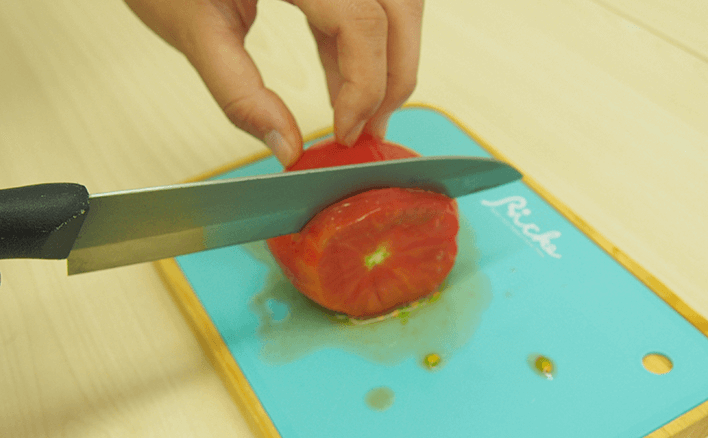
This is because the edge of the knife has become rounded.
If you have a knife that can cut well, you will be able to cut food quickly and enjoy cooking every day.
However, it is a hassle and I don’t know how to sharpen it.
Sharpening knives with a whetstone is a time-consuming process.
In this article, we’ve put together a list of solutions to the simple questions you may have, including how to sharpen your kitchen knives!
Can our kitchen knives be sharpened with a whetstone?
Some kitchen knives can be sharpened with a whetstone and some cannot, depending on the material of the blade.
All kitchen knives are hard to the touch, but some are easy to sharpen and some that are hard to sharpen, depending on the material.
Ceramic knives cannot be sharpened
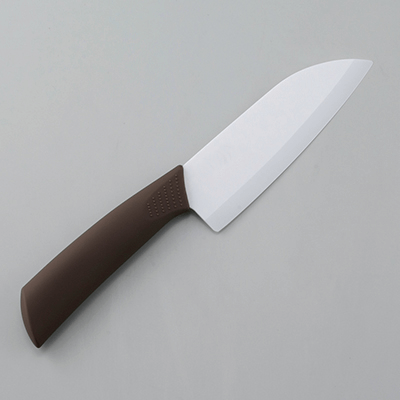
Ceramic knives, which have a white blade, cannot be sharpened with an ordinary whetstone because the blade is not made of metal.
You can use a special diamond sharpener, or the manufacturer or dealer may be able to resharpen it for you.
All other knives can be sharpened
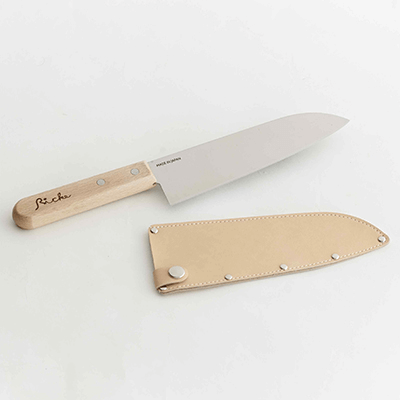
All other materials can be sharpened with a whetstone.
By the way, the blade of the knife in the photo is “stainless steel,” a material that is generally easy to sharpen with a whetstone.
Can’t I just use a sharpener?
There is also a sharpening tool called a “sharpener” that can easily improve the sharpness of knives.
Insert the knife into the groove and pull it a few times to improve the sharpness of the knife.
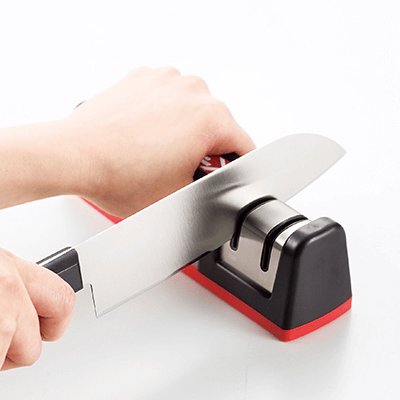
You may be thinking, “If I can improve my sharpness, why can’t I just use an easy sharpener?
You might think.
But! However, since you sharpen only the edge of the blade, this may cause the blade to spill (blade chipping).
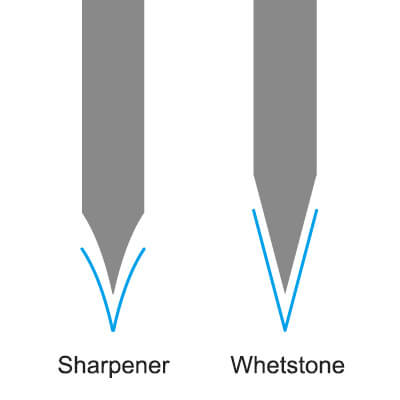
So the sharpener should be used only temporarily, if possible, to bring back the sharpness right away! We recommend that you use the sharpener only temporarily, if possible.
When sharpened with a whetstone, the angle of the cutting edge becomes sharper. The sharpness lasts longer, and the blade is less likely to spill and last longer.
What kind of grinding wheel should I buy?
There are roughly three types of grinding stones depending on the fineness of the grain.
Rough abrasive, medium abrasive, and finishing stones.
Rough abrasive stones are #120 to 600 and are used when the blade is chipped.
Medium abrasive stones are #900 to 2000 and are used when the sharpness of the blade has deteriorated.
The finishing stone is #3000 or more. It is used when you want to make the blade sharp.
If you are using it at home to restore the sharpness, you only need one medium abrasive stone.
Please choose a whetstone according to the condition of your kitchen knife.
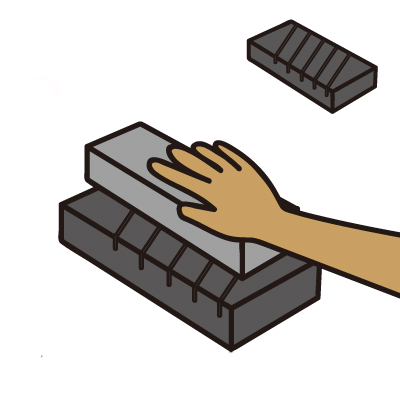
Note that a whetstone with a gouge in the middle will make it difficult to sharpen the knife.
You can correct this with a flattening wheel or a concrete block.
How often do I need to sharpen it?
If you feel that the sharpness is diminishing, you should sharpen it! However, each person’s feeling is different.
If you cook almost every day, once or twice a month is ideal. This will also keep the sharpness of the blade.
You want to take care of your knives frequently, but I try to sharpen my knives when they start to tear when I cut onions.
If you don’t have a lot of time for your daily chores or work, I recommend you give it a try first.
What’s the easiest way to sharpen? Verified using a stainless steel knife!
In this article, I will show you how to sharpen a stainless steel santoku knife.
Shape: Santoku knife
Material: Stainless steel blade
Grindstone used: Medium grindstone (#1000)
1) Soak the wheel in the water
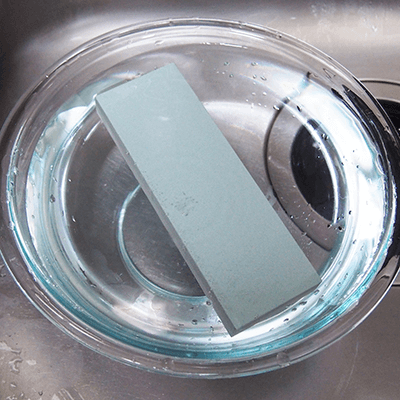
Soak the wheel for about 10 to 20 minutes until no air bubbles come out of the wheel and the wheel absorbs water.
A wheel that has not absorbed water will repel water. Soak the wheel until it no longer repels water.
Check the instruction manual carefully, as it may vary depending on the grindstone.
2) Sharpen the front side
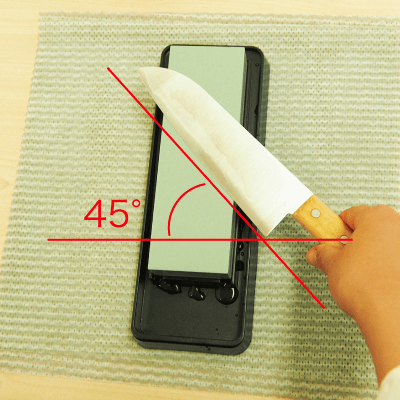
Place the whetstone on a flat surface with a cloth to prevent it from slipping.
Pour water on the whetstone and hold the knife with the blade facing you.
Point the knife at 45 degrees to the grindstone.
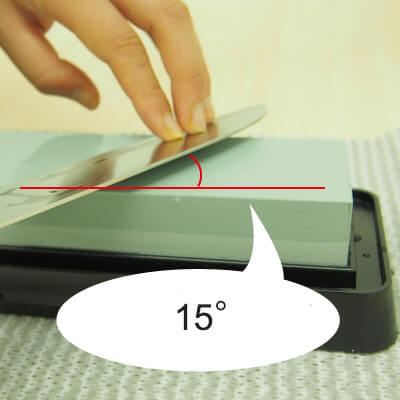
Fix the angle of the cutting edge against the grindstone at about 15 degrees (the equivalent of two 10-yen coins or a pair of disposable chopsticks).
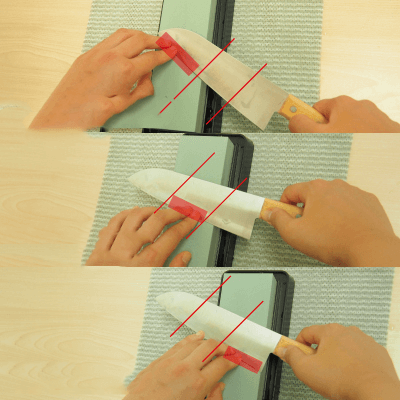
Sharpen the entire blade from the tip (cutting edge), center (middle of the blade), to the base (chin).
First, divide the blade into three sections, and slide each section 10-15 times as a guide.
★ Tips
Push gently from the front to the back. Do not use force when pulling.
Do not wash off the grinding sludge (a mixture of grinding stone and water). This is what makes the knife sharpenable.
If you use the whole wheel to sharpen, it will be easier to clean the wheel itself.
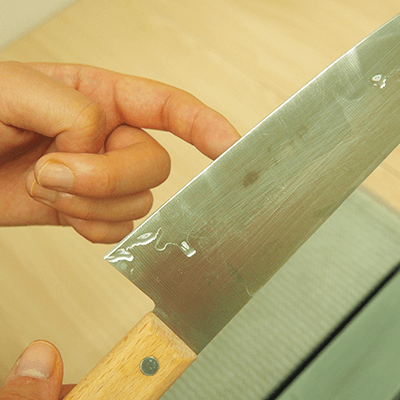
Put your finger on the edge of the blade as shown in the figure, and if you feel a hair’s breadth of scratching, you’ve found the burr. Move on to sharpening the other side.
A burr is a piece of the sharpened blade that appears as if it is turning.
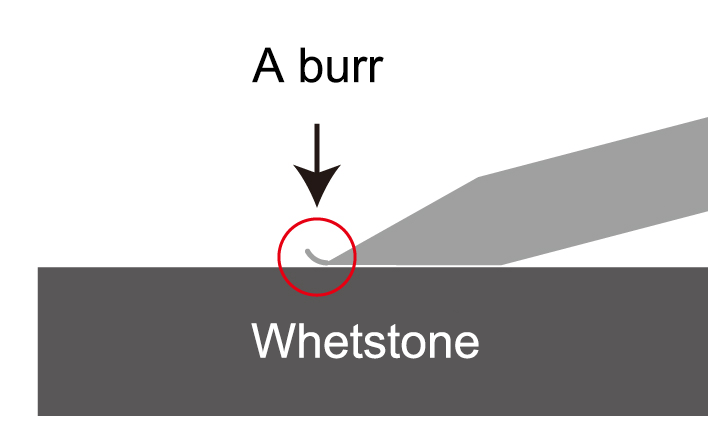
3) Sharpen the backside
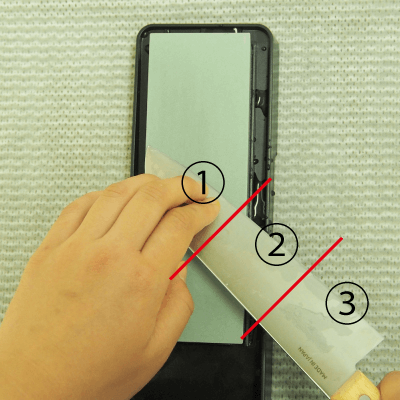
Next, turn the blade to the other side and point the knife at 45 degrees to the grinding wheel.
Keep the angle at 15-20 degrees, and as with the front side, try to slide the blade in three places, about 10-15 times on each.
Sharpen the blade until there is a burr at the tip.
4) Finishing
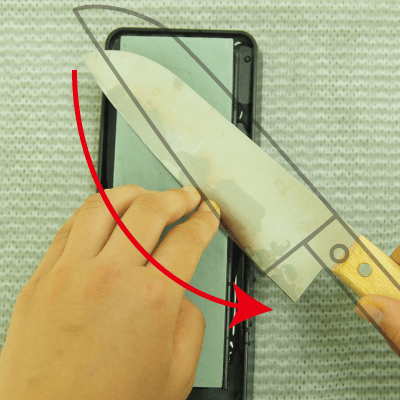
Place the blade on the front surface and keep the angle at 15 to 20 degrees.
Slide the entire blade on the grindstone from the base (chin) to the tip (cutting edge), and lightly sharpen it two or three times to remove burrs.
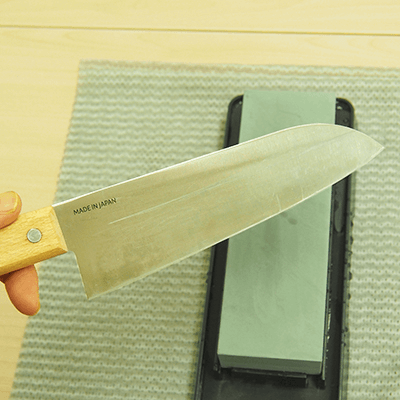
Wash well, wipe dry, and you’re done!
To summarize…
- Sharpen the front surface to remove burrs.
- Sharpen the backside to remove burrs.
- Sharpen the front surface to remove burrs.
What do you do with the wheel when you’re done using it?
Wash it in water, dry it in the shade, and store it in a case when it is dry.
The sharpened knives look like…
I can slice tomatoes this thin!
It feels good to have a properly sharpened knife, doesn’t it?
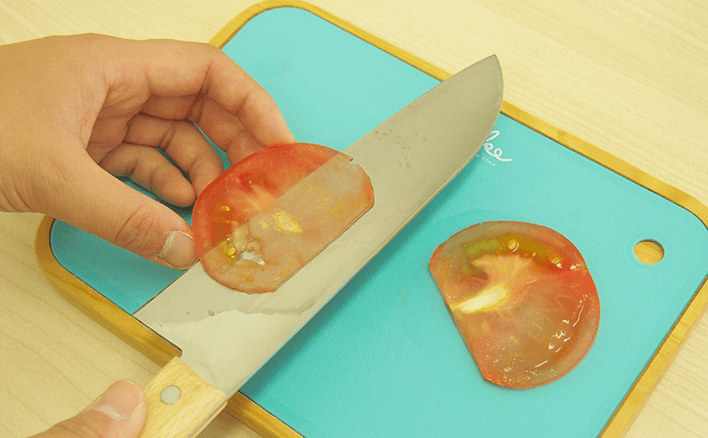
Tips for using kitchen knives for a long time
Knives are prone to spilling (blade chipping) if they are used to cut hard objects or if they are twisted.
Thaw frozen food before cutting.
When cutting fish bones, use a de-bade knife.
You can use your knife for a long time by being aware of these things.
Watch out for rust
Rust can be one of the reasons why knives cannot be cut.
After washing, wipe off the water.
Don’t let the blade touch other metals with water on it. (Touching materials other than stainless steel can cause rusting, called “getting rusted.
Please be aware of these things as well.
Try it first!
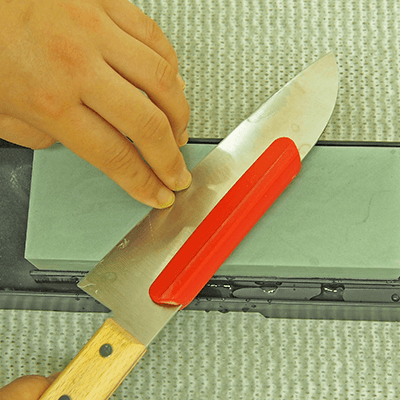
As shown in the photo, some items can be used to fix the angle of the blade.
If you are new to the kitchen and feel uneasy, you can use these items to help you get a feel for it.
If you have a knife that can cut well, cooking will become more enjoyable.
Also, by sharpening it regularly, you can keep the blade in good condition and use it for a long time.
If you only have a medium-grit stone, you can start sharpening, so please try sharpening your knives with a whetstone.